Computers have come far, and they can now perform operations and functions that are completely beyond human capabilities. All the credit for this goes to various engineers and scientists who worked towards revolutionizing computer technology and kept setting the bar high for future engineers.
Nowadays, you can turn your light on and switch it off again by using your voice. But how is all this possible? What basic thing did it take for computer technology to reach such heights? The answer to this question is – Programming.
Before diving into the depths of C programming, we must first understand what a program is.
A program is a set of instructions that performs desired operations when executed.
Now you should know that a computer does not understand English or any other language and has to be instructed in some particular languages (Binary Language) constructed for this purpose. One of those languages is the C language. Now, let us understand what it is.
Table of Contents
What is C Programming?
C is a structured, general-purpose procedural programming language, and it is one of the most popular programming languages of all time. Why? We will come to that later. First, let us look at the basics of C.
C is used to create programs that can perform simple and complex functions and are highly used in the industry, even today. Now, let us look at the history of the C Language.
History Of C Programming Language
C has its roots lying in ALGOL. ALGOL can be called the mother of all programming languages since it introduced the concepts of structured programming to users. It was first introduced in 1960.
After ALGOL, another revolutionary programming language was introduced in 1967, which was called BCPL (Basic Combined Programming Language). BCPL was specially designed to write system software.In 1970, another programming language known as B was introduced to the world by Ken Thompson, and it was an extension of the features of BCPL. Based on the structures of all these programming languages and learning from their strength and weaknesses, C programming language was born in 1972.

C was created by Dennis Ritchie in 1972 at Bell Laboratories. It introduced numerous additional concepts that were not present in the programming languages before it and were designed to solve complex problems.
But, the main purpose of developing C was that the programmers at that time felt the need for a new language to specifically write software like Operating Systems.
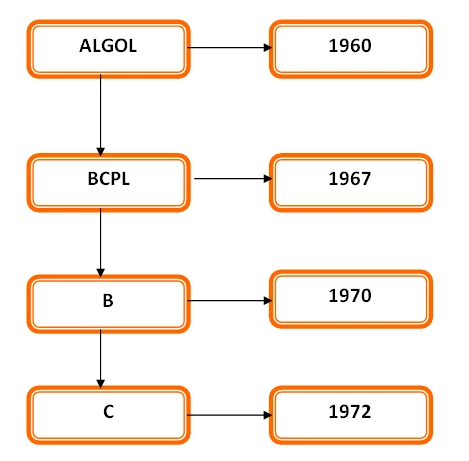
Initially, C was supported just by the UNIX OS, but as it got introduced to the world and more programmers started to realize its worth, it gained wide recognition, and many cross-platform compilers came into the market so that its C’s limitation to UNIX could be dealt with.
C went commercial and gained wide popularity, making it one of the most popular programming languages of all time, and is widely used even to this day.
Features of C Programming Language
- C has numerous libraries containing built-in sets of functions and operators which can be used to write any program of any level of complexity.
- It has a variety of data types and operators, so the programs written in C are usually faster and much more efficient than those written in other programming languages.
- C is machine-independent, which means that a program can be written in C on Linux, but it can also run on other Operating Systems like Windows.
- It has libraries that contain functions. We can create our functions and add them to the library.
- C can be used to write heavy software like Operating Systems.
Applications of The C Programming Language
- C language can be used to write and design software like Operating Systems and compilers, but it is not limited to that and can be used to design virtually any program.
- It can also be used to design application software like a database.
- C is often used to design mobile and computer games.
- This can also be used to solve complex mathematical problems.
- C Programming is highly used in designing Graphic User Interface (GUI) applications.
Structure of C Program in the C Programming
The basic structure of a C program is discussed in this section of the article. But first, you need to know the importance of writing Algorithms before you go on to create an actual program.
Algorithms are instructions written in a human-understandable format and work as a rough structure of the actual program. So, for better understanding, we will take an example of the most basic and popular C program known as the “Hello World!” program.
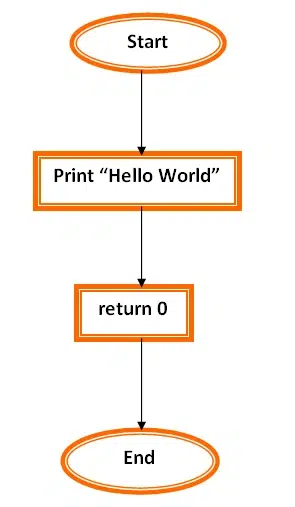
Algorithm
- Open Notepad
- Write ‘#include<stdio.h>’ to include the standard library functions like printf and scanf.
- Call the function ‘main.’
- Function Printf print the Hello World statement.
- Save the file as .c extension.
- Run the file using a compiler.
Write a Program to Print the Output on the Screen.
#include <stdio.h>
int main()
{
printf(“Trickyedu”);
return 0;
}
Description of the Program
The first thing we wrote in this program is – #include<stdio.h> The # represents the pre-processor directive. This is used to include the contents of another file in our program.
The other file we are trying to include is the header file known as stdio.h which contains standard input-output functions like printf and scanf. Scanf function is used to take input from the user, and the printf function is used to print output to the screen.
So, in our program, the next thing we do is write – int main(). Here, we are calling the function main. The use of this is to return some integer value at the end of the program to tell about its successful or unsuccessful execution.
Usually, for successful execution, 0 is returned, and for unsuccessful execution, 1 is returned.
Now, we use {. This signifies the starting of our actual program.
The next thing we do is write – printf (“Hello World!”). You already know that printf functions display output on the screen.
; is used to end the statement.
We type – return 0; it tells the compiler for successful execution.
We end the program with }
Why Use C?
- C Programming is one of the most widely used languages today, and there are reasons for it.
- It contains a very small number of keywords, and they are all easy to remember, which eases things up.
- C is rich in data types that can be widely used in several ways.
- This programming language can be used for creating both simple programs and complex programs like Operating Systems.
- Programs written in C are very easy to understand and edit.
- C is extensible.
Compilation Process in C
The compilation is the process of converting code from a high-level to a machine-understandable (low-level) format. This task is done by a compiler. The compilation process in C is divided into various stages, where each stage performs some specific function. Let us understand these stages in detail,
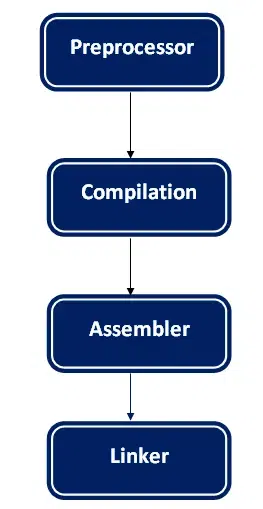
Preprocessor
Preprocessing means performing some functions before the compilation of the actual program takes place. Some instructions are written at the starting of the code. For example – #include<math.h> is used to include mathematical symbols and calculations into the program. So, during the preprocessing stage, the compiler processes instructions, header files, and macros.
Compilation
This is the second stage, where the source code is executed to generate a file, which is known as the assembler source code.
Assembler
The third stage of the compilation process takes the assembler source code and generates an object file.
Linker
This is the last step of the compilation process. All the libraries and object files are taken and combined into one file. This combined file is known as an executable file.
Let us take a look at the various files that are generated during the compilation process.
- During the assembly stage, an object file is generated, which has the extension .obj (in Windows) and .o (in Linux). This object file contains the source code, which has been converted into machine language.
- During the final stage of the compilation process, an executable file is generated. This file is a combination of various object files and other header files. An executable file is the final product of the compilation process. This file is opened to produce the desired outputs.
Installation of Code Blocks on Windows
Before you start writing your programs, you need to have the necessary software. This software is – a text editor and compiler. Write the programs into the text editor while the compiler compiles and executes the programs. Text editors and compilers are already present in operating systems. Notepad is one of them.
After you write a program in notepad, you have to save it and then compile it using the command prompt. This process might be a bit hectic. So, to make it all easy, Integrated Development Environments (IDEs) are used.
IDEs provide you with all the necessary software in one place. You can create, compile, and run your programs in a single environment using IDEs. One of the best IDEs in the market today is Code Blocks. Let us take a look at the installation process of Code Blocks.
- Click here to download Codeblocks. This link will lead you to the download section of Code Blocks. Now you have to scroll down and select the “code blocks-16.01mingw-nosetup.zip”. This version is the most useful because it will install the GCC compiler on your system.
- When the download is done, run the setup. Accept the license and click on next. Then, you will be asked to choose the elements you want to install. Select ‘Full’ in the drop-down menu and click on Next.
- Choose the folder where you want to install Code Blocks. Click on Next.
- Code Blocks will now be installed on your system. Click on Finish.
Online Compilers
Some compilers and IDEs are also available online. You just have to visit the website without installing anything on your system. Some of the best online compilers are listed below.
OnlineGDB
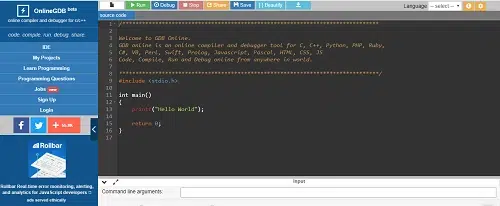
OnlineGDB includes a code editor, a compiler, and a debugger. It supports numerous languages like C, C++, python, java, PHP, etc. The debugging process is very helpful in this one.
CodeChef
CodeChef will provide you with a great IDE experience as it is very similar to a desktop IDE. It supports top languages like C, C++, and Java. It is the best option for students who need to make programs quickly.
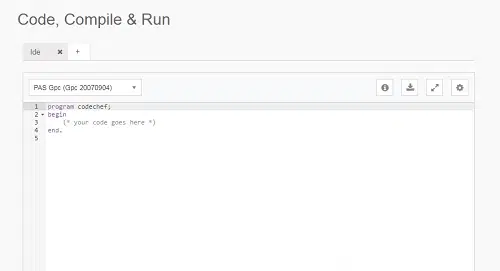
Codepad
It supports numerous languages like C, C++, java, python, etc., and is a powerful tool. Codepad also works well on mobile phones, which is unique about it. You can easily share and save your code using this.
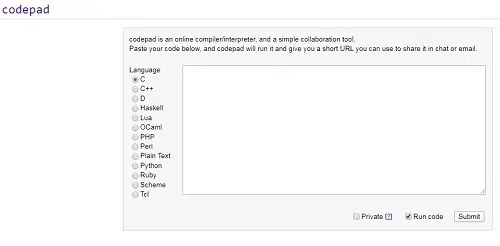
IDEone
This is somewhat similar to an online DB and is a powerful compiler and debugging tool. IDEone supports 50+ programming languages. You can easily share, save, and edit your code using this.
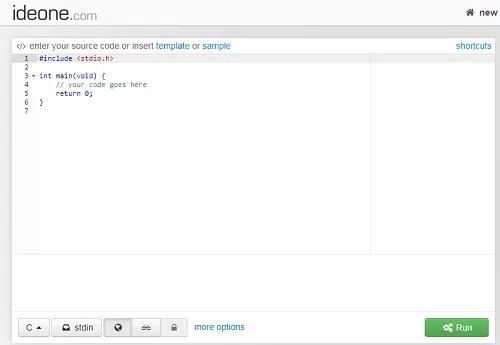
Must Read Various Topics in the C Programming Language
- Identifiers, keywords, constants, data types, operators
- What are Operators in C Programming Language?
- What is Operator Precedence in C Language?
- Must read if, if-else, nested if-else, for, while, do-while loop, break, jump, continue, switch statement
- Ultimate Guide on Different Types of Functions in C
- What is Recursion in C Programming?
- Various aspects of pointers in C Programming language?
- What is Double Pointer in C?
- How to avoid Null Pointer Dereference in C?
- How to dereference a CHAR pointer in C?
- How to Dereference a Void pointer in C?
- How Dangling pointer in C affects your programming?
- What is Array in C Programming Language?
- Learn Various aspects of string in C Programming.
- How to find Substring in the main string in C?
- Program to reverse a string without using strrev in C
- How to Concatenate two strings?
- How to convert a string into lowercase?
- How to change a string into uppercase?
- How to implement functions strncpy and strcpy in C?
- How to compare two strings?
- How to use storage classes in C Language?
- What is Program memory layout?
- Preprocessor directives in C language
